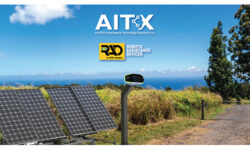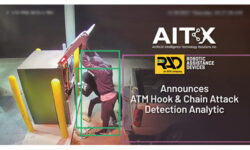Experts From Robolliance Make a Case for Robotics in Security
Five Robolliance Expert Sponsors hold court on myriad robotics’ topics. A prominent common thread is the huge upside for these emerging technologies to gain a foothold in security.

The first-ever Unmanned Security Expo (USE) debuted at ISC West 2017.
The first-ever Unmanned Security Expo (USE) successfully debuted at the International Security Conference & Expo (ISC West) in Las Vegas (April 2017) — helping the electronic security industry’s already highest profile trade show soar to a record number of more than 30,000+ participants.
With a focus on unmanned aerial vehicles (UAVs), unmanned ground vehicles (UGVs) and various systems to support robotic technology, the show within a show included a fully functional flight cage and robotics demonstration area, booth exhibits and free education sessions.
Robolliance, a forum for technology partners and industry experts in robotics, surveillance and security, created to advance the understanding and awareness of the autonomous robotics marketplace, served as one of the four primary USE supporters.
Robolliance sponsors, comprised of technology companies, security integrators, guard services and industry thought leaders, were on hand to welcome attendee inquiries and address the greater questions of “Why Robotics? Why Security? Why Now?”
Directly across from the Robolliance Sponsor Showcase was the Expert Corner, where experts spoke one-on- one with attendees.
Among the Robolliance Sponsors onsite at the inaugural USE were Experts from the Coalition of UAS Professionals, Genentech, IGM Creative Group, MiB Mediaworks and RF-MOON.
To ascertain what the first-hand reaction and response was to that event, and expand into what it means for the security industry moving forward as well as other trade shows, RoboFYI conducted a roundtable involving representatives from each organization.
Why did you participate in the USE at ISC West? What did you hope to gain from the experience, and how did it work out?
 ERIC MORSE, Senior Security Manager, Genentech: “It was an opportunity to dialog with peers on the upcoming advancement in robotics and how the technology can be used now with the right equipment and services to augment your security program. Robotics can be a force multiplier and allow for additional layers of security protection for your people, property and information.
ERIC MORSE, Senior Security Manager, Genentech: “It was an opportunity to dialog with peers on the upcoming advancement in robotics and how the technology can be used now with the right equipment and services to augment your security program. Robotics can be a force multiplier and allow for additional layers of security protection for your people, property and information.
I learned from subject matter experts in many industries and within specific niches, which was very helpful. There was great dialog and partnership between different companies and industries. Overall, it was overall a great experience.”
 NATHAN RUFF, Director, Coalition of UAS Professionals: “The Coalition of UAS Professionals worked in concert with [ISC organizers] Reed Expositions to orchestrate the USE. Our hypothesis was, that although unmanned robotics is still a bleeding-edge technology, the security industry would recognize the potential and be interested in better understanding how drones, droids and underwater robots could be leveraged successfully.
NATHAN RUFF, Director, Coalition of UAS Professionals: “The Coalition of UAS Professionals worked in concert with [ISC organizers] Reed Expositions to orchestrate the USE. Our hypothesis was, that although unmanned robotics is still a bleeding-edge technology, the security industry would recognize the potential and be interested in better understanding how drones, droids and underwater robots could be leveraged successfully.
We initially planned to have the educational area provide seating for 25-30 attendees, but we quickly doubled that capacity after the first session. Reed placed pressure sensors under the entire expo floor carpet to conduct heat-mapping, which provided better intelligence on foot traffic patterns, high
volume areas, etc.
The USE area ended up being the hottest spot on the show floor. With 30 companies exhibiting their technologies, two days of educational sessions and the demo area where folks got to see drones and droids in action, USE gave attendees a real glimpse into the future of security and unmanned robotics. The experience was a big success.”
 MARK BRODIE, President, MiB Mediaworks: “We thought this was a great way to get involved in the latest advances in security technology. ISC West offered me an opportunity to meet with various companies in the security industry, that support the UAGVs [unmanned automated ground vehicles], giving me access to thought leaders in an area I have not worked with before.
MARK BRODIE, President, MiB Mediaworks: “We thought this was a great way to get involved in the latest advances in security technology. ISC West offered me an opportunity to meet with various companies in the security industry, that support the UAGVs [unmanned automated ground vehicles], giving me access to thought leaders in an area I have not worked with before.
Through my conversations with individuals I met at the conference, I gained new contacts and created relationships with some very passionate and insightful individuals. Through these relationships, I see quite a few opportunities that will become available creating great collaborative efforts in the future around robotics.”
 TOM DIETZ, Owner, RF-MOON: “I was at ISC West to assist Sharp’s Robotics Group. To be effective, the robot requires a fair amount of reliable bandwidth to support the streaming video from six cameras. My goals at the show were to be an informed source for information about outdoor wireless networks that enable mission-critical applications.
TOM DIETZ, Owner, RF-MOON: “I was at ISC West to assist Sharp’s Robotics Group. To be effective, the robot requires a fair amount of reliable bandwidth to support the streaming video from six cameras. My goals at the show were to be an informed source for information about outdoor wireless networks that enable mission-critical applications.
Additionally, USE provided a way to introduce myself to Sharp’s customers and to make sure that future robot owners knew where to go for the wireless network installation, integration and support. I was surprised at the level of interest in a security-focused robot and was able to provide information to quite
a few prospects.”
 JAY STACK, President, IGM Creative Group: “The Robolliance kiosk at USE was quite impressive as it too was demonstrative of people interacting with technology. Booth visitors were able to use the touchscreen to dynamically swipe through topics, read articles, peruse through a multitude of experts and their profiles, plus contact all of the Robolliance sponsors. It was amazing. The large interactive touch monitor really made the booth and its products stand out.
JAY STACK, President, IGM Creative Group: “The Robolliance kiosk at USE was quite impressive as it too was demonstrative of people interacting with technology. Booth visitors were able to use the touchscreen to dynamically swipe through topics, read articles, peruse through a multitude of experts and their profiles, plus contact all of the Robolliance sponsors. It was amazing. The large interactive touch monitor really made the booth and its products stand out.
It’s great that the Robolliance had so many sponsors attend as it offered USE patrons the ability to gain expertise on a variety of robotic related topics.”
Are there any aspects of USE that could have been better and/or could be improved for future?
RUFF: “The one area we didn’t leverage well enough was the drone cage/demo space. Originally, our goal was to set the drone cage up as a “near-to- real” demonstration of competing technologies. The idea was to pit offense technologies, such as infrared sensing from a UAV platform, against counter-UAS technologies, like RF tracking and discouragement.
Effectively, the space would have been a scrimmage of sorts between offensive and defensive tech. This would have likely been a more defining experience for attendees, who at this point have already seen drones buzz around and ground robots drive themselves without human intervention. Alas, perhaps next time.”
What were some of the comments/questions you overheard or fielded in and around the USE regarding robotics’ role in and relationship to security?
STACK: “There are so many companies, who have focused their attention to security and new innovation, that it’s hard to sift through those that have a viable product.”
DIETZ: “Most comments about robotics and security were focused on the cost savings model. One security guard for the show brought up the safety benefits. Apparently, a colleague of hers, another security guard, was killed when he investigated something suspicious.The woman at the show pointed out that the robot helped to keep human security guards out of harm’s way.”
RUFF: “Comments and questions were many. . . What can this technology do in a real-world scenario? Are autonomous/semi-autonomous robots safe? There seems to be a meaningful convergence between autonomous vehicles and unmanned robotics. Can a drone utilize machine vision and learning to independently navigate around obstacles? How do unmanned robots employ predictive analytics to provide advanced security?
I’m amazed that a combination of acoustic and visual anomaly detection algorithms can be employed that provide a security robot capabilities beyond traditional sentry patrols. I understand that unmanned robots can provide advanced situational awareness, but what are the legalities involved with weaponizing a robot so that it can take “interdictory action” if necessary?”
BRODIE: “One main concern seemed to be the displacement of security workers or employees. This question is one the industry will struggle with as other industries have, such as automotive and hospitality. Technological changes forces the evolution of occupations. I think events and groups, like USE and Robolliance, create a place for dialogue and help steer that conversation.”
MORSE: “There was a great conversation about the future of robotics within the prison industry that I thought was fascinating. The prison industry relies heavily on personnel to conduct a lot of the dull, dirty and dangerous activities that robots can do without the cost and potential risk of life. The prison industry also relies heavily on recurring activities that take place 10 to a hundred times a day. These very repetitive types of activities could be done with the use of robotics, which could free up staffing and may be more accurate.”
What were your takeaways from the experience?
BRODIE: “The security business is a lot larger and more expansive than I ever imagined. The technology being used today seems to have changed a great deal over the last few years, adding new and exciting opportunities for many companies in the security space.”
STACK: “Innovations are changing every three years now. You don’t want to fall behind.”
RUFF: “Unmanned robotics are going to play a tremendous role in the future of security.”
MORSE: “The importance of finding the right person, who has accurate information, so you can learn from the source directly and not rely on third-party insights. This makes you a more knowledgeable customer and end user. Everyone has areas of strengths and/or special skill sets. By tapping into a network of individuals, who provide you a wide selection of various knowledge base, makes life easier. You benefit from smarter transactions and an end state that is constantly raising the benchmark.”
How fast do you see the robotics tie-in to security growing and why?
DIETZ: “There will be a lot of interest immediately, but some hesitation to implement the rest of the system due to cost and good ole resistance to change.”
BRODIE: “The possible long-term cost savings in using robotics is a real incentive for many companies looking to lower their labor costs. This cost savings will need to be analyzed by real-world business practices, but logic tells me using robotics will save those, who need this type of security, a lot of money.”
RUFF: “Unmanned ground robots are already patrolling office complexes, malls, etc. But the technology still has some wrinkles to work out as we are seeing in the headlines. Mishaps will get worked out, but erode industry confidence in the near term. I’d suggest 18-36 months before we see widespread implementation of ground-based, autonomous security robots. With regard to airborne unmanned robotics, that is likely to take a bit longer simply because the FAA needs to come up with a plan on how to certify and regulate autonomous flight within the national airspace.
That’s more likely to be three years out, but once those regs are in place, drones will be able to zip off to inspect triggered alarms without any human intervention providing a rapid response capability currently unavailable. The end result will be a greatly improved level of situational awareness from a security perspective.”
MORSE: “I see robotics fazing in over the next two to four years and really being present in every aspect of security within a decade. Security is part of the life-safety industry, so when there is life at stake innovation takes a backseat to robust operations that are repeatable regardless of the time of day, weather or existing circumstance. Because of this, robotics may be a bit delayed to really become ingrained, but there is no doubt that it will someday. The real question is in what form will it arrive in and how will it be used?”
What are some of the best opportunities in this area and why? Likewise, what are some of the top challenges in this area and why?
DIETZ: “The best opportunity will be in showing the end user the technologies, that are put in place to support the robot, will also support a wide variety of other voice, video and data applications. Convincing people that a reliable network can be provided using unlicensed frequencies can prove to be difficult. Conversely, convincing people that outdoor wireless networks are significantly different animals than the simple Wi-Fi access point most are familiar
with.”
MORSE: “The best opportunities are ones that do not replace human activity, but enhance it and create a force multiplier where one human plus one robot is a lot more than two. If we argue to enhance our current staffing model with this additional tool, I think it makes a lot of sense to embrace robotics and use them to increase the security of your organization. Counter to that, if you are looking for robots to reduce your security budget by eliminating the human aspect I believe we are several decades from that being a reality, and it may be even longer than that.”
Who do you see being some of the earliest adopters of robo-security and why?
MORSE: “I see a lot of advancement in the AUGV platform, which can be used now to monitor and patrol fence lines, parking lots and exterior areas. Add to this security perspective is the safety component, such as the capability to monitor air quality.”
RUFF: “Large campuses that require legions of traditional patrols to maintain security are likely early adopters. Also prisons, government installations, anywhere that manned security is dangerous or dull, provides a great opportunity to allow robots, in the air or on the ground, to provide significant value.”
DIETZ: “The earliest adopters are going to be those who can bring in the supporting technologies without having to do a forklift upgrade of an existing system. Often, this will be new businesses. Next will be those who can show clear financial losses due to criminal activity. And finally, with the focus on worker safety, locations that have extreme weather conditions will see the benefit in not having a human guard walk the perimeter when it is 120⁰ F or 0⁰ F.”
What other trends and growth are you observing of late regarding robotics awareness and interest, including tradeshows, publications, news, media, etc.?
DIETZ: “I see a general trend toward automation in the outdoor operation. This is being facilitated by the same thing that drove the dotcom boom. Technology, that is founded on IP packets, offers not only the opportunity to optimize processes, but also an opportunity to reduce costs by converging outdoor voice, such as Push2Talk, LMR, video and data onto a single network. The Internet of Things and machine-to-machine communications is all about automation. A robot focused on security is a natural outgrowth of a population that is looking to automate repetitious or dangerous jobs.”
STACK: “News coverage for robotics is doubling rapidly. You can’t watch the daily reports or open the paper without some kind of article or video about robots. Owning an ad agency, I can tell you the cost of a PPC [pay per click] ad is higher than it’s ever been for robotics. We are looking at the future.”
RUFF: “The unmanned robotics industry is new. As such, those organizations and individuals currently pushing it forward within the security vertical are still out on the edge. That said, it only takes a couple of success stories to attract investors’ attention. With talks about colonizing Mars, high-speed underground hyperloops and the commercialization of space, the excitement of high technology and the future is captivating imaginations again. Our country went through a period where dreaming big technologically went out of fashion, replaced by the idea of the Internet start-up millionaire.
It’s a great thing to see how unmanned robotics is playing a role in this new era and getting folks excited again. One interesting area in the future will be when drones start acting as true IoT devices. With 7 million drones estimated to be operating in the U.S. airspace alone by 2020, imagine the amount of information that will be collected as these devices automatically report back to central databases. This information can be used productively, such as real-time weather capture, or for less altruistic reasons such as tracking what time of day you leave for the office and return in the evening. Food for thought.”
Check out the latest issue of RoboFYI, the Robolliance Newsletter!
If you enjoyed this article and want to receive more valuable industry content like this, click here to sign up for our FREE digital newsletters!

Security Is Our Business, Too
For professionals who recommend, buy and install all types of electronic security equipment, a free subscription to Commercial Integrator + Security Sales & Integration is like having a consultant on call. You’ll find an ideal balance of technology and business coverage, with installation tips and techniques for products and updates on how to add to your bottom line.
A FREE subscription to the top resource for security and integration industry will prove to be invaluable.















